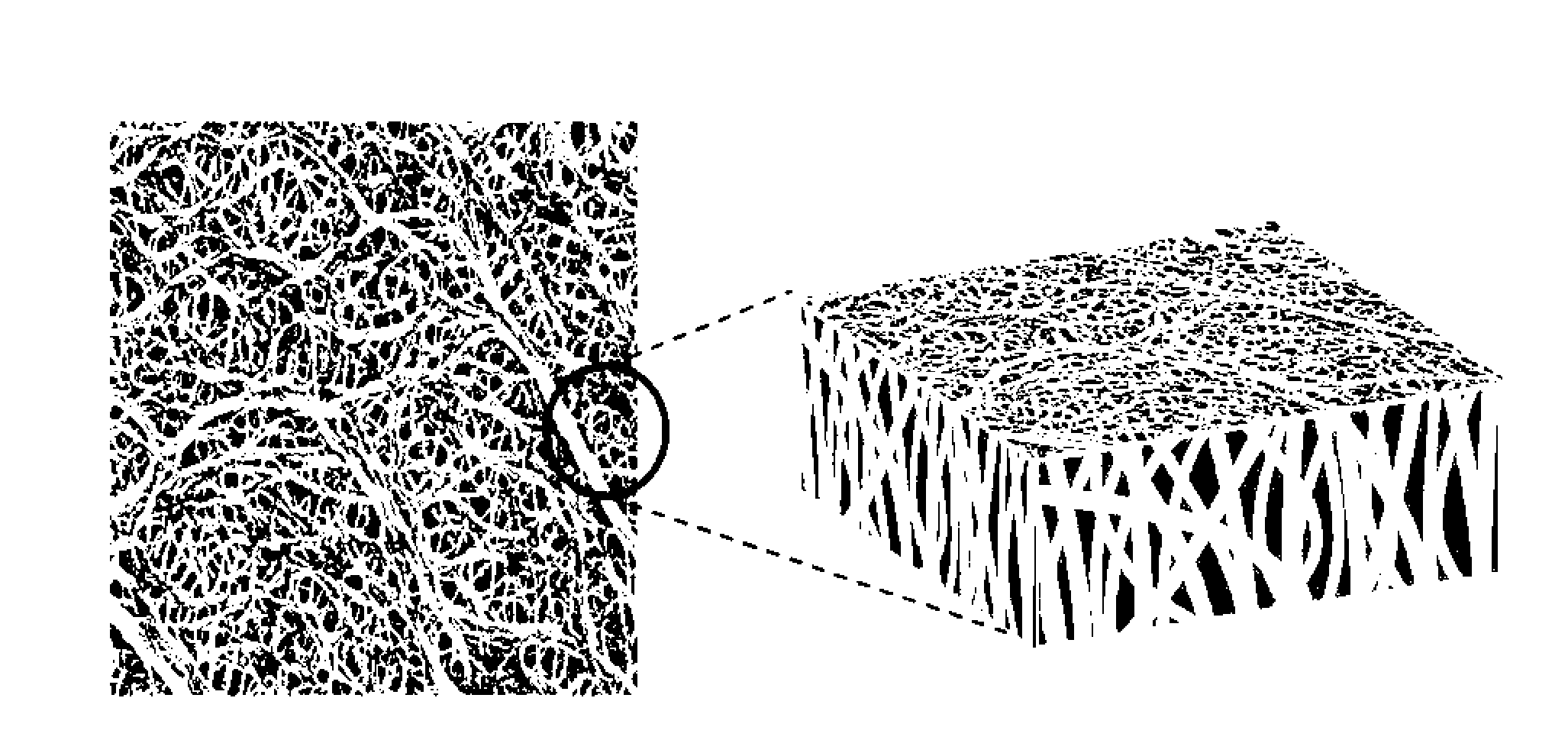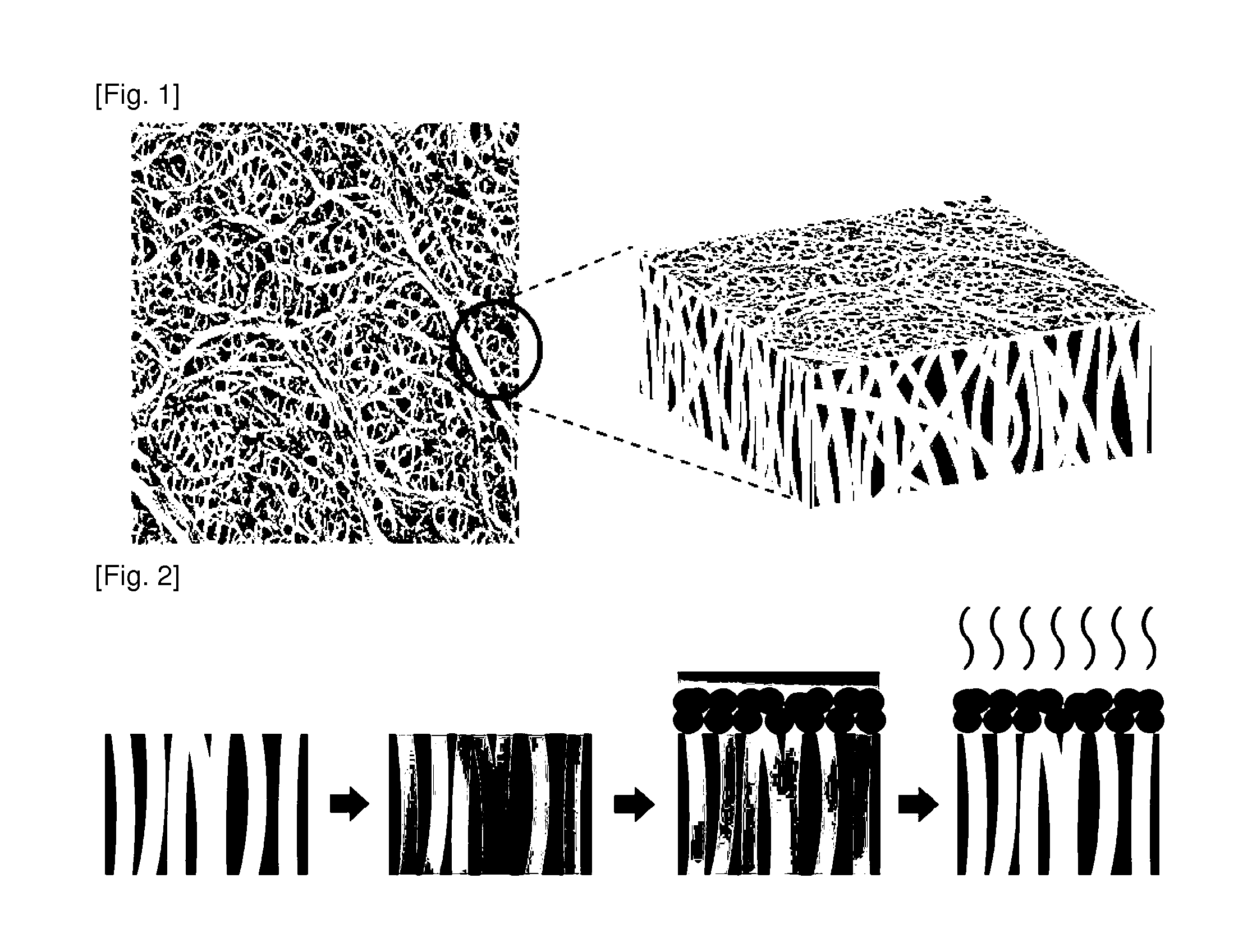Pore Protected Multi Layered Composite Separator and the Method for Manufacturing the Same
a multi-layered composite separator and composite separator technology, applied in the direction of cell components, cell component details, membranes, etc., can solve the problems of increasing the shutdown temperature to a melting temperature, affecting the safety of the system, etc., to achieve excellent permeability and shutdown function, high safety, and excellent performance
- Summary
- Abstract
- Description
- Claims
- Application Information
AI Technical Summary
Benefits of technology
Problems solved by technology
Method used
Image
Examples
example 1
(1) Selection of a Substrate
[0059]A polyolefin microporous film used as a substrate was a separator for a secondary battery composed of a polyethylene single layer and having a thickness of 11.9 μm and a permeability of 141 sec / 100 cc.
(2) Preparation of a Coating Solution
[0060]23 g of a poly(vinylidene difluoride-hexafluoropropylene) (PVdF-HFP) polymer resin (a weight average molecular weight=450,000) was dissolved in 522 g of THF to prepare a solution with a concentration of 4.22 wt %, and 37.0 g of alumina (Al2O3) (average diameter=0.5 μm) was introduced to this polymer solution and agitated to prepare a coating solution in a ratio (by mass) of (inorganic particles) / (polymer resin)=1.61.
(3) Pore Protection by a Solvent
[0061]A die coating process that passes a THF solvent, which has a solubility of 14.7% to the PVdF-HFP polymer resin, through a slot die toward a cross-section of the separator substrate to coat the substrate, was implemented to apply the THF solvent to one face of t...
example 2
(1) Selection of a Substrate
[0065]A polyolefin microporous film used as a substrate was a separator for a secondary battery composed of a polyethylene single layer and having a thickness of 12.3 μm and a permeability of 141 sec / 100 cc.
(2) Preparation of a Coating Solution
[0066]23 g of a PVdF-HFP polymer resin (a weight average molecular weight=450,000) was dissolved in 522 g of THF to prepare a solution with a concentration of 4.22 wt %, and 36.3 g of alumina (Al2O3) (an average diameter=0.5 μm) was introduced to this polymer solution and agitated to prepare a coating solution in a ratio (by mass) of (inorganic particles) / (polymer resin)=1.58.
(3) Pore Protection by a Solvent
[0067]A dip coating process that includes dipping the separator substrate in a bath including a methylethylketone (MEK) solvent, which has a solubility of 5.1% to the PVdF-HFP polymer resin, taking the substrate out of the bath, and removing the solvent that remains on the surface of the substrate using a Meyer b...
example 3
(1) Selection of a Substrate
[0071]A polyolefin microporous film used as a substrate was a separator for a secondary battery composed of a polyethylene single layer containing 5% of polypropylene and having a thickness of 9.3 μm and a permeability of 160 sec / 100 cc.
(2) Preparation of a Coating Solution
[0072]16 g of a polyarylate (PAR) polymer resin (a weight average molecular weight=61,000) was dissolved in 519 g of chloroform (CHCl3) to prepare a solution with a concentration of 2.99 wt %, and 64 g of titanium dioxide (TiO2)(an average diameter=0.5 μm) as an inorganic material was introduced to this polymer solution to prepare a coating solution in a ratio (by mass) of (inorganic particles) / (polymer resin)=4.00.
(3) Pore Protection by a Solvent
[0073]A dip coating process that includes dipping the separator substrate in a bath including a carbon tetrachloride (CCl4) solvent, which has a solubility of 2.7% to the PAR polymer resin, taking the substrate out of the bath, and removing the...
PUM
 Login to View More
Login to View More Abstract
Description
Claims
Application Information
 Login to View More
Login to View More - R&D
- Intellectual Property
- Life Sciences
- Materials
- Tech Scout
- Unparalleled Data Quality
- Higher Quality Content
- 60% Fewer Hallucinations
Browse by: Latest US Patents, China's latest patents, Technical Efficacy Thesaurus, Application Domain, Technology Topic, Popular Technical Reports.
© 2025 PatSnap. All rights reserved.Legal|Privacy policy|Modern Slavery Act Transparency Statement|Sitemap|About US| Contact US: help@patsnap.com



